John R. Fultz's Blog, page 63
July 1, 2013
GOIN’ BACK TO ASGARD w/ Big John Buscema

John Buscema’s first issue of THOR was #178, but he would return as the regular series artist with #182. And thus began the 70s (known to comic fans as the Bronze Age), when Jack Kirby moved to DC and Buscema stepped up to redefine the look of Marvel Comics.
One of the immortal Jack Kirby‘s greatest creations was THE MIGHTY THOR. Much has been said and written about Kirby’s years-long run on this classic title. It might even surpass his immortal FANTASTIC FOUR run as my favorite of his Marvel creations. However, one of my all-time favorite post-Kirby artists is the great Big John Buscema.
This summer, for the first time, I’m reading my way through the initial Buscema run on THE MIGHTY THOR.
I have about 17 classic issues in blazing full color from the glorious 15- and 20-cents era, beginning with THOR #183 up to #203 (with about three issues missing). If I were to buy all the actual Buscema issues (which begin in 1970) it would run into thousands of dollars. Luckily, I have the THOR ESSENTIALS Volumes 4, 5, and 6, which carry me nicely all the way to #247. And Volume 7 will be released in October 29.
The Essentials volumes are in black-and-white, but the art of John Buscema (usually inked by the amazing Joe Sinnott here) is so entirely superb, I don’t even miss the color. Oh, sure, I’ll read the dog-eared old full-color issues that I have, but the bulk of my journey through Buscema’s THOR years will be in black-and-white, where the pencils and inks take center-stage.
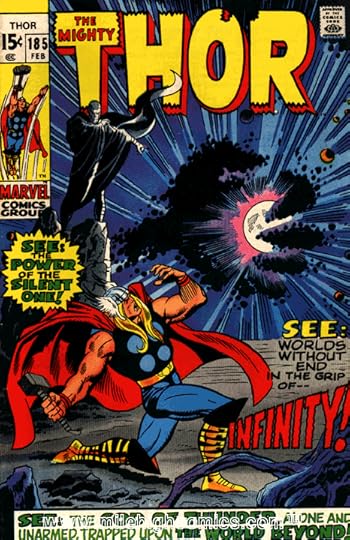 According to his Wikipedia page, John Buscema worked on THE MIGHTY THOR #178, 182-259 (with only a few breaks for fill-in artists), then returned for #272-278 and #283-285. During this time he also did 3 THOR Annuals. So as you can see, this is a journey that won’t be complete in a single summer. I have several years of Buscema’s THOR to enjoy as the issues are released in further Essentials volumes. (Perhaps down the road I’ll go back and collect them all in full-color Marvel Masterworks editions, but right now you get way more issues-per-volume with the b/w Essentials.)
According to his Wikipedia page, John Buscema worked on THE MIGHTY THOR #178, 182-259 (with only a few breaks for fill-in artists), then returned for #272-278 and #283-285. During this time he also did 3 THOR Annuals. So as you can see, this is a journey that won’t be complete in a single summer. I have several years of Buscema’s THOR to enjoy as the issues are released in further Essentials volumes. (Perhaps down the road I’ll go back and collect them all in full-color Marvel Masterworks editions, but right now you get way more issues-per-volume with the b/w Essentials.)
It’s no easy thing to fill the shoes of Jack Kirby—the man who practically invented modern comics and established the Marvel Universe—but John Buscema not only did this several times, he helped move many Stan Lee/Jack Kirby creations to the next era of greatness.
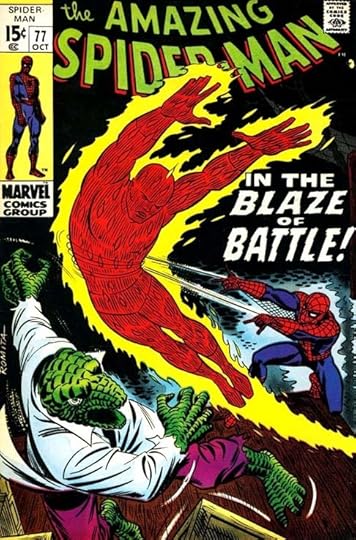 I grew up in the 1970s (born in ’69), and started reading comics before I hit elementary school. The first comic I remember picking up and “reading” (although I didn’t know how to read yet) was AMAZING SPIDER-MAN #77, with stunning art by—you guessed it Big John Buscema. In this issue, Spider-Man is trying to defeat the Lizard while convincing the Human Torch to leave the beast alone (he doesn’t want to reveal that the Lizard is really his friend Dr. Kurt Conners). But the Torch won’t butt out, so there are some great scenes of Spidey vs. Torch vs. Lizard here. I remember this was the first time I had seen the Human Torch (although I had doubtless seen Spider-Man on the TV cartoon show). The images in that book imprinted a pattern on my young consciousness–a pattern set by the phenomenal art team of John Buscema and Joe Sinnott. THIS was Marvel Comics to me, from then on.
I grew up in the 1970s (born in ’69), and started reading comics before I hit elementary school. The first comic I remember picking up and “reading” (although I didn’t know how to read yet) was AMAZING SPIDER-MAN #77, with stunning art by—you guessed it Big John Buscema. In this issue, Spider-Man is trying to defeat the Lizard while convincing the Human Torch to leave the beast alone (he doesn’t want to reveal that the Lizard is really his friend Dr. Kurt Conners). But the Torch won’t butt out, so there are some great scenes of Spidey vs. Torch vs. Lizard here. I remember this was the first time I had seen the Human Torch (although I had doubtless seen Spider-Man on the TV cartoon show). The images in that book imprinted a pattern on my young consciousness–a pattern set by the phenomenal art team of John Buscema and Joe Sinnott. THIS was Marvel Comics to me, from then on.
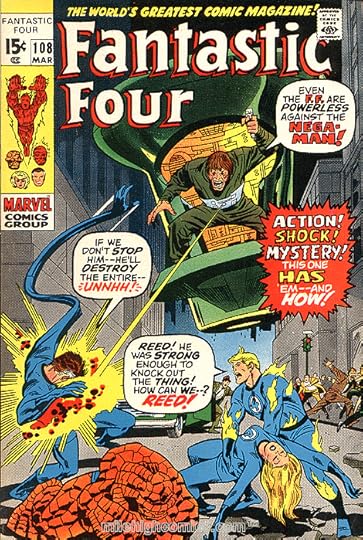
FF #108 Buscema’s second issue and one of my all-time favorite comics covers.
Not long after this, I discovered my first issue of FANTASTIC FOUR. It was the infamous #108, with art by Buscema (who had just taken over for Jack Kirby, whose name I didn’t know at the time), but part of the issue was composed of left-over Kirby pages, shown as a “flashback.” But it was the COVER of this book that made my jaw drop and captured my imagination, once again imprinting on my brain in a way that said THIS is how comics should be done.
And who drew the cover? Of course it was Big John Buscema.
Many years later I learned the story of Marvel: How Stan Lee and Jack Kirby built it from the ground up (with a lil’ help from Steve Ditko), and made comics history until Kirby left the House of Ideas in 1970. Well, that was just about my entry point into the world!
So while the previous generation grew up revering Kirby as the King of Comics, for me it was John Buscema who was king. (Later—in my teen years (the 80s), John Byrne took that crown with his work on UNCANNY X-MEN and FANTASTIC FOUR, but he would share it with Frank Miller for his legendary DAREDEVIL run.)
 When Kirby left Marvel in ’70, it could have meant the end. However, Stan Lee was smart enough to let the House Style evolve. Artists like John Buscema, Gil Kane, Jim Steranko, Rich Buckler, (and others) took up the best facets of Kirby’s work, but added an extra layer of realism—in the tradition begun by Neal Adams and Jim Aparo in the mid-60s. Buscema had done the super SILVER SURFER title (because Stan felt Kirby was too busy with his other books), he had taken THE AVENGERS to new heights years after Kirby created it, and now he came along and replaced Kirby no not one but TWO main Marvel books: THOR and FANTASTIC FOUR.
When Kirby left Marvel in ’70, it could have meant the end. However, Stan Lee was smart enough to let the House Style evolve. Artists like John Buscema, Gil Kane, Jim Steranko, Rich Buckler, (and others) took up the best facets of Kirby’s work, but added an extra layer of realism—in the tradition begun by Neal Adams and Jim Aparo in the mid-60s. Buscema had done the super SILVER SURFER title (because Stan felt Kirby was too busy with his other books), he had taken THE AVENGERS to new heights years after Kirby created it, and now he came along and replaced Kirby no not one but TWO main Marvel books: THOR and FANTASTIC FOUR.
As a kid discovering comics, I knew none of this. I simply knew amazing artwork when I saw it. John Buscema became the new paradigm of a Marvel artist—something even Stan Lee recognized when he had Buscema be his partner on the book HOW TO DRAW COMICS THE MARVEL WAY. Had this book been done five years earlier, it would have probably been Kirby instead of Buscema. Indeed, a lot of the lessons Buscema iterates in the book are lessons learned from studying Jack Kirby’s work.
Kirby’s work effected every artist who came after him, he was THAT important.
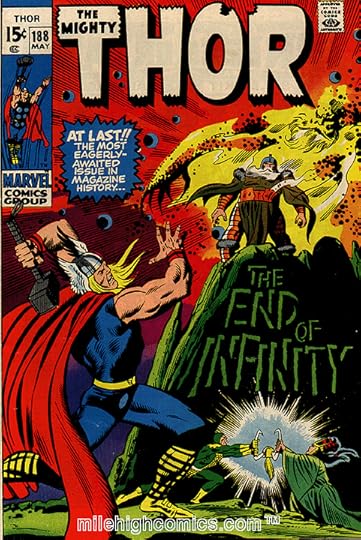 So, when I say that the John Buscema run on THOR and FANTASTIC FOUR are my favorite runs of those comics, I do not disparage the amazing and seminal work of the great Jack Kirby in creating those concepts and maintaining/evolving them for most of a decade. There is no doubt that Kirby was and still is “The King of Comics.” However, I grew up on John Buscema, not Jack Kirby. And there’s something about that you cannot avoid.
So, when I say that the John Buscema run on THOR and FANTASTIC FOUR are my favorite runs of those comics, I do not disparage the amazing and seminal work of the great Jack Kirby in creating those concepts and maintaining/evolving them for most of a decade. There is no doubt that Kirby was and still is “The King of Comics.” However, I grew up on John Buscema, not Jack Kirby. And there’s something about that you cannot avoid.
John Buscema, in my mind, was every bit the genius that Kirby was—in his own way. Perhaps this is why others have called Buscema “The Michelangelo of Comics.” Others have called Kirby “The Picasso of Comics.”
Now, for the first time, I’m able to sit back and discover the spectacular work Buscema did on THOR when he took over for Kirby. (I also have his entire FANTASTIC FOUR run in Essentials volumes–but that’s a later post.) I’m completely amazed at the quality of these issues—having read only a handful of them so far—and I’m even more amazed by this fact: Buscema drew FF and THOR simultaneously!
Big John came in and not only replaced Kirby on one of his most iconic titles—but TWO at once! Much has been written about Kirby’s Herculean work ethic—and Buscema had to be cut from that same cloth. Today’s comics artists don’t draw two monthly titles at once. It’s just not done anymore.
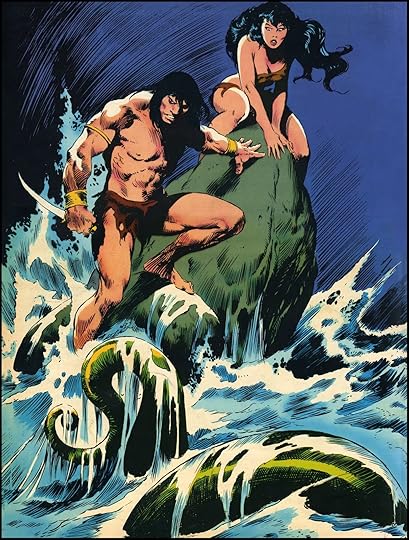
When John Buscema had the luxury of inking his own pencils (as he does here in a CONAN illustration) the results hearkened back to the great artists of the comics strips: Alex Raymond, Russ Manning, and Hal Foster.
These classic runs (THOR and FF) were nearly impossible to find when I was a kid, but I grew up reading Buscema’s CONAN THE BARBARIAN. That was my biggest “Buscema fix” as a young’un (although I loved the reprints of his 60s AVENGERS run in Marvel Triple Action). Later I discovered that he had replaced another master, Barry Windsor-Smith, who started CONAN at Marvel. When you have a giant talent and you need to fill his shoes—you got Big John Buscema. This is one of the big lessons you learn when you look at his career.
I’ve always had Buscema’s CONAN issues, and enjoyed them time and time again. In addition, he did tons of issues of THE SAVAGE SWORD OF CONAN, the black-and-white “mature readers” magazine. Just as he had drawn FF and THOR on a monthly basis at the same time, Buscema did the CONAN color comic and the SAVAGE SWORD magazine simultaneously. The word “prolific” barely even describes it.
Buscema had a number of inkers during his long tenure at Marvel, but he always preferred to ink himself. I always found it a rare treat when I found a Buscema pencilled-and-inked issue (or cover). My favorite Buscema inker growing up was Ernie Chan (in the CONAN color comic) and Tony DeZuniga (in SAVAGE SWORD). However, now that I’m finally able to read Buscema’s THOR run, I have to say that Joe Sinnott was the perfect choice for it.
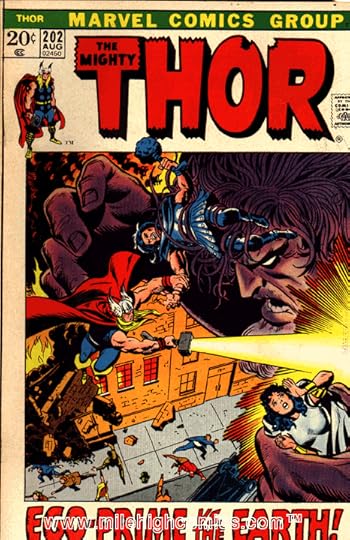 The Buscema/Sinnott artwork is as gorgeous to look at as the Kirby/Sinnott combo was. Sinnott is considered one of the best inkers Kirby ever had, and I maintain that he is definitely also one of the best inkers to lay a brush across John Buscema’s pencils.
The Buscema/Sinnott artwork is as gorgeous to look at as the Kirby/Sinnott combo was. Sinnott is considered one of the best inkers Kirby ever had, and I maintain that he is definitely also one of the best inkers to lay a brush across John Buscema’s pencils.
So how did Buscema fill Kirby’s shoes? Stan Lee stayed on as writer until #193, when he turned the writing reins over to Gerry Conway. What a prime gig this must have been for the new-to-comics Conway. More than anything else, this was Buscema’s show. (Or The Buscema/Sinnott Show, to be more precise.)
Buscema came in with a bang: Odin summons Thor back to Asgard, where a threat beyond any other looms near. The approach of The World Beyond and a mysterious being known only as Infinity are literally “eating up” the universe. Worlds and stars are being snuffed out or mindlessly enslaved as this force moves across the cosmos. Odin goes off to fight Infinity alone, but Thor soon follows.
This first major Lee/Buscema story arc (after a quick two-issue Doctor Doom tale) is as cosmic and interstellar as anything Kirby ever did—Thor and Odin (with some help from the enignmatic Silent One) are literally battling to save the entire universe. Infinity makes Galactus look like a chump! (There’s a great scene where we see Galactus slumbering on a distant planetoid, his tummy full of the most recent planet he’s devoured.)
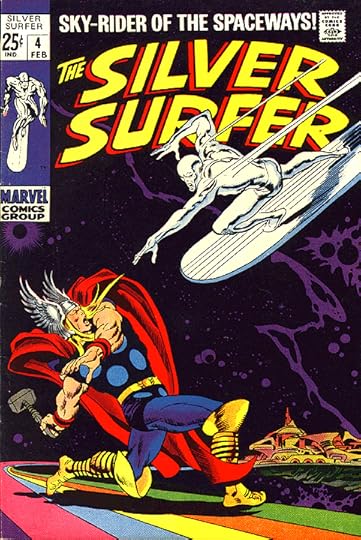
Coming off his extra-galactic SILVER SURFER run, John Buscema brought his stellar “cosmic” sensibility to bear on his THOR run, which would last far longer.
The reason Buscema brought such a cosmic vibe to THOR right off the bat is obvious to any comics scholars: He was coming off his 17-issue SILVER SURFER run, a comic that turned Norrin Rad from a supporting character into one of comics’ all-time great icons. Many years ago I acquired the wonderful Marvel Masterworks full-color editions of the original SILVER SURFER—it was way too short, and now Buscema’s tour de force continues in the pages of his THOR run.
By the time the unguessable secret of Infinity is revealed, the earth itself has faced a cataclysm of Biblical proportions. Thankfully, when all the cosmic dust has settled, the Odin-power is there to restore the broken universe. Yet Thor is left with a huge debt to pay the Hela, the Goddess of Death. Hela has always been one of my favorite Kirby creations, and in the hands of Buscema she is even more gorgeous and deadly.
I’m still at the beginning of my “journey back to Asgard” in the company of the masters Buscema and Sinnott, but already I find it utterly inspiring and at times even breathtaking in its sheer perfection of comic art excellence. There is so much great stuff to discover in the issues that follow: Kartag the Keeper, the return of Mangog, Ego-Prime, the Legions of Pluto, the Mark of Mephisto, Ulik the Troll-King, the Demon Brigade, Xorr the Spawner of Worlds, the Keeper of the Inner Cosmos, Hercules, Galactus, Firelord, Odin in Exile, the Time-Twisters, and more…
Later I’ll go back and read Buscema’s initial FANTASTIC FOUR run—the one he drew at the same time he was doing all these great THOR tales. Even though these runs were created and published simultaneously, I can only take in so much brilliance at one time.


June 26, 2013
The Great Aparo
 Ah, summer. The time when I can not only write as much as I want, but also READ as much as I want. This summer, I have dived back into comics in a big way. One of the great things about comic books as an art form is that there’s always something spectacular to discover—even if it was published decades ago.
Ah, summer. The time when I can not only write as much as I want, but also READ as much as I want. This summer, I have dived back into comics in a big way. One of the great things about comic books as an art form is that there’s always something spectacular to discover—even if it was published decades ago.
This summer I’m on a serious Jim Aparo kick. Aparo’s Silver Age and Bronze Age work was simply amazing. The artist is best known for his runs on Aquaman, Phantom Stranger, and Brave and the Bold (Batman), but he did tons of other work. When Neal Adams came to comics in the mid-60s, he set a new standard for stylish, photo-realistic artwork that few people could match, and he changed the face of comics. Jim Aparo was an artist in that same style.
Both of these artists could have been right at home on Madison Avenue doing high-profile advertising illustrations (and in fact Adams did come from that field). Both Neal and Aparo utterly captured the look and feel of 1960s American—and they made it look fantastic. I can’t watch an episode of MAD MEN without thinking how much certain characters look like Jim Aparo drawings.
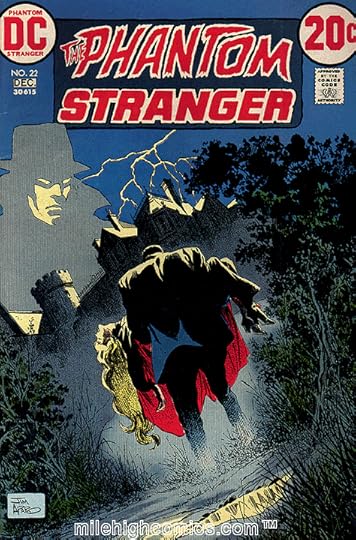 For a long time I’ve been searching out Aparo’s issues of the original PHANTOM STRANGER comic. A couple of years ago the entire run was finally collected in DC’s SHOWCASE PRESENTS: PHANTOM STRANGER Volumes 1 and 2. Even in black-and-white Aparo’s art is gorgeous. Last year I picked up the SHOWCAWSE PRESENTS: THE SPECTRE collection, which begins in the 60s but also includes Aparo’s early 70s run on the character in the pages of ADVENTURE COMICS. Spectacular stuff. Aparo followed Neal Adams on both of these titles–which given their similar styles is no coincidence.
For a long time I’ve been searching out Aparo’s issues of the original PHANTOM STRANGER comic. A couple of years ago the entire run was finally collected in DC’s SHOWCASE PRESENTS: PHANTOM STRANGER Volumes 1 and 2. Even in black-and-white Aparo’s art is gorgeous. Last year I picked up the SHOWCAWSE PRESENTS: THE SPECTRE collection, which begins in the 60s but also includes Aparo’s early 70s run on the character in the pages of ADVENTURE COMICS. Spectacular stuff. Aparo followed Neal Adams on both of these titles–which given their similar styles is no coincidence.
Now I’ve never been much of an AQUAMAN fan, and in fact I’ve laughed at the popular jokes made about this character who “fights crime underwater.” But Jim Aparo did one of the most legendary AQUAMAN runs in the character’s history, and came back to do another one a few years later. His first run on the character was in the original Silver Age AQUAMAN comic (#40 -56), and in the 70s he came back to do an 11-issue revival of the character in ADVENTURE COMICS–this was a direct follow-up to his SPECTRE run in that same title. The original AQUAMAN Aparo run has yet to be collected, but a peek at the pages of these issues reveals some truly gorgeous artwork. Both of these runs are now on my list of classic must-haves.
Fortunately, BATMAN fans will have an easier time getting a fantastic Aparo fix. The artist’s long-standing BRAVE AND THE BOLD run has been collected in a full-color hardcover edition called LEGENDS OF THE DARK KNIGHT: JIM APARO Vol. 1. These were the stories that cemented Aparo’s legend, since Batman is one of the most high-profile characters ever. I’m sure I’ll pick this volume up eventually, but it’s his non-Batman work that thrills me the most.
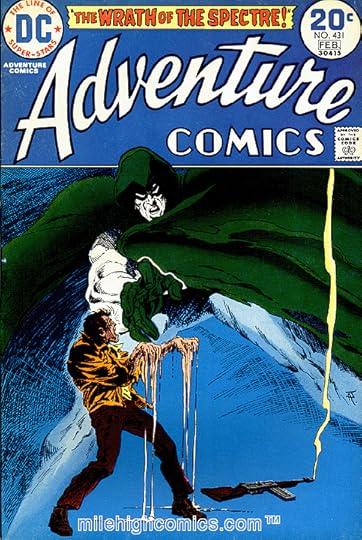
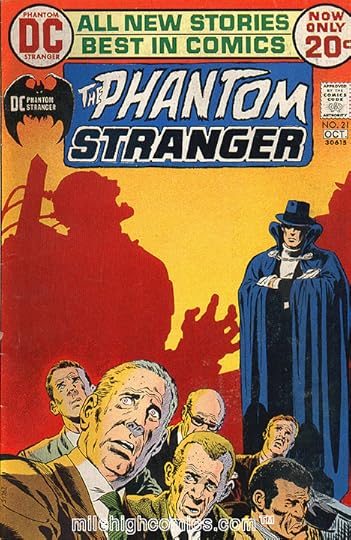 Phantom Stranger and The Spectre are two of my favorite comics of all time, and looking back now at the age of 43, this is all due to the great Jim Aparo. His work was my first exposure to these DC characters and—much like John Buscema’s work defined Marvel Comics for me at an impressionable age—Jim Aparo’s version of these mysterious beings became the definitive versions in my mind.
Phantom Stranger and The Spectre are two of my favorite comics of all time, and looking back now at the age of 43, this is all due to the great Jim Aparo. His work was my first exposure to these DC characters and—much like John Buscema’s work defined Marvel Comics for me at an impressionable age—Jim Aparo’s version of these mysterious beings became the definitive versions in my mind.
Come to think of it, the only Aquaman comics I bought as a kid had Aparo artwork as well. I’ve heard other comics fans say that the Aparo Batman is THE Batman
to their minds, and I have to agree with that as well.
Jim Aparo was a true giant of the comics field,
and we need more of his great work in collected editions.
Until then, I’ll be hitting the back issue bins.


June 20, 2013
THE REVELATIONS OF ZANG: Kindle -&- Nook
I’m pleased to announce that THE REVELATIONS OF ZANG
is now available in BOTH Kindle and Nook formats.

Click for larger view
A collection of dark fantasy tales with a metaphysical edge, full of grotesque wonders and weird splendor. Artifice the Quill flees from tyrant sorcerers into a world of strange magic, ancient gods, and exotic kingdoms. The exiled author joins a traveling troupe of performers known as the Glimmer Faire, where he learns the magical power of art and the art of magical power. These Twelve Tales of the Continent alternate between the exploits of Artifice and the adventures of Taizo the Rogue, a master of skullduggery who sparks a rebellion in the name of bloody vengeance.
The Lost Gods of Narr were displaced a century ago by the Sorcerer Kings, a council of dictators who rule the Golden City with necromancy, alchemy, and terror. The mysterious folk of the Red Isle foster dissension in Narr by smuggling their enchanted goods into the city, while the ancient Zang Forest expands itself across the lands of men, devouring farms and towns as it reaches to smother the wicked city.
Now that the Lost Gods are returning to destroy the world, only Artifice, Taizo, and a small band of rebels have any hope of preventing the apocalypse. Seven of these interrelated stories are previously unpublished, including the 16,000-word novelette “Spilling the Blood of the World,” which brings the entire Zang Cycle to a staggering finale.


June 11, 2013
TRAILER: The Desolation of Smaug
The trailer for THE HOBBIT, Part 2, “The Desolation of Smaug” has just arrived,
and it is — in a word — awesome.
Watch it. ‘Nuff said.


June 4, 2013
The Adventures of Artifice the Quill

Click for larger view
It’s here! My first-ever short story collection,
THE REVELATIONS OF ZANG, is now available as a Kindle e-book at Amazon.com for $4.99.
(A Nook version will follow soon, and there are plans for a Limited Edition print version eventually.)
At last the entire Zang Cycle is presented in a single volume. It all began with “The Persecution of Artifice the Quill” in WEIRD TALES #340, then the story-cycle hopped over to BLACK GATE magazine for the next few years. Five of the tales were published in WT and BG, while the remaining seven tales are presented here for the first time.
I’ve spent the last couple of months perfecting, revising, and updating the text of each story. Josh Finney (Titanium Rain) did the amazing cover art, which features Artifice the Quill and Taizo of Narr, who star in most of the stories. The grand finale to the entire cycle is a 16,000-word novella, “Spilling the Blood of the World.”
In one sense THE REVELATIONS OF ZANG is a series of stories about the power of storytelling. The tales that Artifice writes are brought to life by his skilled troupe of performers and the clever illusions of Mordeau the Showman. Is this Sword & Sorcery? More like “Pen & Sorcery”. When I began writing the first of these tales, I wanted something rather different for fantasy: a central protagonist who is, first and foremost, an intellectual.
[image error]
The cover of WT #340 featured the deadly Vizarchs from “The Persecution of Artifice the Quill,” the story that began the Zang Cycle.
Artifice is a writer whose fame in Narr the Golden City thrusts him into a world of peril. The Quill isn’t saddled with the role of a reluctant savior, or weaned on blood and iron to lead a conquering army. No, his is a thinker, a philosopher, an Artist. His journey is one of discovery, as he explores the link between Art and Sorcery.
Taizo of Narr started off as a supporting character, but drew my attention again and again, until he became the “second lead” of the series. In many ways he is the opposite of Artifice—his tool is a blade, not a pen. Taizo begins as a self-concerned opportunist, a thief and smuggler. His are the arts of larceny and skullduggery. Unlike Artifice, who is a slave to his craft, Taizo is driven by raw emotions. He is a man pushed too far, and ultimately bent on revenge at all cost.
Definitely there are some statements about the nature of Art and its essential relationship to humanity in these stories. You may see a reflection of today’s self-obsessed politicians in the narcissistic personages of the Sorcerer Kings. You may see your local tortured artist glimmering in the eyes of Artifice the Quill. You may see yourself in the grieving, desperate moments of Taizo’s journey.
“The Persecution of Artifice the Quill” was my first professionally published story, and it gave birth to this entire cycle. I always intended to collect these stories someday under a single cover. I’m really glad that day has come at last.
Artifice and Taizo have been waiting long enough…


June 1, 2013
THAT IS NOT DEAD: Historical Lovecraft

Michael Whelan’s beautifully creepy illustration for a mid-80s Lovecraft collection.
Horror fans know H.P. Lovecraft as the father of “cosmic horror” and the man who invented Cthulhu, Azathoth, Nyarlathotep, and host of other legendary monsters known as the Great Old Ones. His body of work also inspired its own genre of horror fiction—the Lovecraftian Mythos.
I’ve been pleased to have stories in such Lovecraftian anthologies as CTHULHU’S REIGN and THE BOOK OF CTHULHU II. Now PS Publishing (the publisher that brought us BLACK WINGS I & II) has assembled an impressive new anthology under the editorship of the great Darrell Schweitzer.
THAT IS NOT DEAD features all-new tales of cosmic horror set in various periods of history. You might call it “Historical Lovecraft.” The title comes from one of Lovecraft’s most famous lines: “That is not dead which can eternal lie, yet with stranger eons, even death may die.”
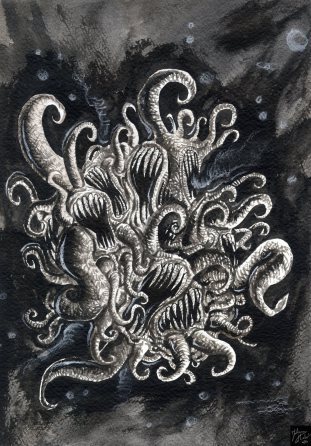
Azathoth, as rendered by CRODEART
Here’s what Schweitzer has to say about the concept:
“THAT IS NOT DEAD is a collection of Mythos stories, based on the premise that if the Old Ones have been around since elder aeons, someone should have noticed before Lovecraft’s characters did about 1900. The theme then is lurking presences. Inasmuch as the stories deal with history, it is secret history, i.e. “what really happened…”
I wrote a story called “Anno Domini Azathoth” for the book, and I’m humbled to be in the company of so many fine writers. My tale is set in the wild Arizona Territory in the late 1700s. It involves an obscure Amerindian cult of Azathoth worshipers, and the missionary priest who discovers their horrible secret.
It also purports to tell the “real story” behind the all-too-real massacre of two Spanish missions in 1781. Like most of these tales, it peels back the layers of known history to reveal the mind-blasting horrors that lie beneath.
Here is the current Table of Contents:
John Langan – “The Horn of the World’s Ending”
S.T. Joshi – “Incident at Ferney”
Harry Turtledove – “Nine Drowned Churches”
Don Webb – “Slowness”
Esther Friesner – “What a Girl Needs”
Keith Taylor – “Herald of Chaos”
John R. Fultz – “Anno Domini Azathoth”
Will Murray – “Smoking Mirror”
Jay Lake – “Monsters at the Top of the World”
Richard Lupoff – “The Salamanca Encounter”
W.H. Pugmire – “Old Time Entombed”
Lois Gresh – “Of Queens and Pawns”
Darrell Schweitzer – “Come, Follow Me”
THAT IS NOT DEAD is set for a Fall release. I’ll be sure to announce it right here when it arrives.


May 30, 2013
Essential Truths VI
“We do not experience a material world.
We experience sensations, images, feelings, and thoughts in awareness,
and [we] interpret them as a material world.”
– Chopra


May 20, 2013
World Fantasy Award Nominations Now Open
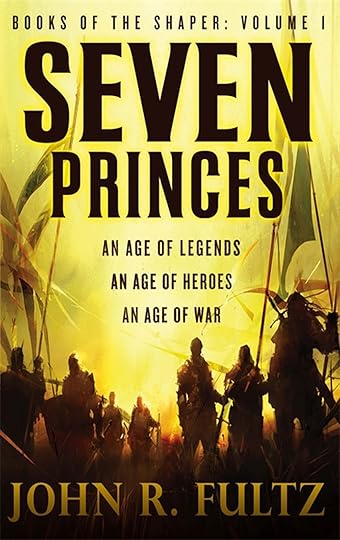 World Fantasy Award Nominations are open until May 31st.
World Fantasy Award Nominations are open until May 31st.
YOU can vote if you attended WFC in 2011, 2012,
or are registered for WFC 2013.
SEVEN PRINCES is eligible for nomination in the Novel category.
Please vote!!! The ballot is right here:
http://www.wfc2013.org/wfballot01.html


May 17, 2013
Vireon vs. the Sea Serpent

Click for much larger version
This is soooo cool…
Back when the great Richard Anderson was submitting ideas to Orbit for the cover of SEVEN PRINCES, he did an illustration inspired by a specific scene from the book. It’s from Chapter 23: On the Cryptic Sea, wherein Prince Vireon battles a colossal Sea Serpent, a deed that earns him the title “Vireon the Slayer.”
Until now I had only seen the rough “thumbnail” of this piece, but Rich recently posted the finished version on his flaptraps art blog. I couldn’t resist posting it here as well. Rich’s covers have received universal praise, and his SEVEN PRINCES cover even made the most recent edition of SPECTRUM.


May 16, 2013
“Assassins of Youth”
This bone-crushing tune from Wayne Static is my latest obsession.
Play it LOUD, or skip it altogether.






